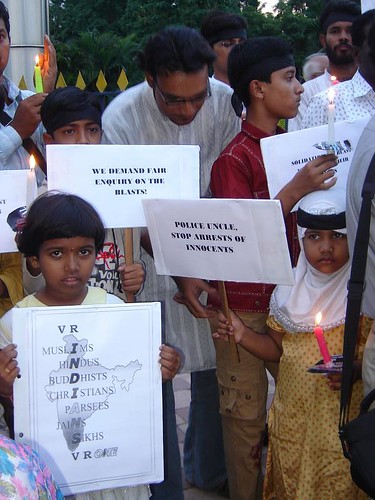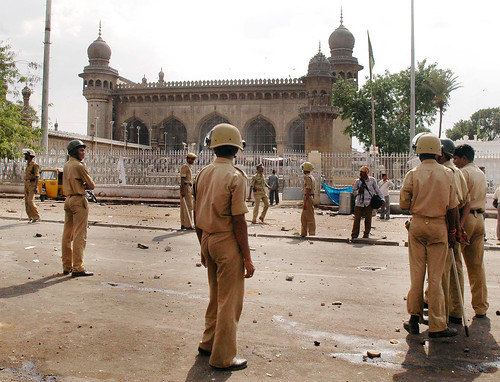How Babri Masjid demolition gave birth to violence among Muslims in Hyderabad and how police fanned it further
By Mohammed Siddique, TwoCircles.net,
Hyderabad: As the country marks the 16th anniversary of the black day when the centuries old Babri Masjid was razed to the ground by the Hindu-militants, for the city of Hyderabad it is an important milestone for another reason. The day also marks the dawn of the era of militancy among the Muslim youth.
Never before the December 6, 1992, the word of militancy or terrorism was heard among the Muslims in Hyderabad nor was any terror related case booked against them. But in the dark hour of Indian democracy, the first case of TADA was booked against a group of Muslims led by one little heard religious figure Mohammed Naseeruddin when he tried to offer Namaz on the road in the busy commercial area of Abids in the heart of the city. What should have been attracted mere fine for disrupting the traffic ended up in first case under Prevention Terrorism and Disruptive Activities Act commonly known as TADA.
This set the tone for a train of sad and tragic events propelling more and more promoting the militant mentality among the Muslims in Hyderabad, as they lost faith in the system and starting seeing the established political Muslim leadership as a failure and ineffective and believed the establishment had taken the side of the saffron brigade.

Early 1993 was rocked by the murders of two BJP workers who were self proclaimed Karsevaks who participated in demolition of Babri Masjid. It was followed by the first major encounter involving the Muslim youth. Three persons Mohammed Faseehuddin, Mohammed Rafeeuddin and Mahmood Ali were killed by the police in what many called a fake encounter. The police said they were militants involved in the killing of two BJP-RSS workers. Faseehuddin, whose associates were later called “Faseeh Gang” in police records, became an iconic figure for the Muslims in Hyderabad and other parts of the state.
It was followed by several incidents of minor bomb blasts across the city and the police later arrested one Jalees Ansari and his associates in connection with these incidents. Almost 14 years later, in 2007 all accused in the case except Jalees Ansari were acquitted by the court for lack of evidence.
Meanwhile several Pakistani citizens were also arrested on the charges of conspiring to carry out terrorist attacks in the city. They include Ishtiaq Ali alias Saleem Junaid and Mohammed Farooq. Some of them have already completed their sentence and gone back to Pakistan.
Meanwhile Hyderabad police made many claims of busting ISI modules, foiling terror conspiracies and arresting the agents. But it also came under fire for framing the local youth in false cases and branding innocent youth as terrorists. In 2002 after a bomb exploded outside a temple in Dilsukhnagar area of Hyderabad, two local youth Mohammed Azam and Abdul Aziz were killed in two incidents which were largely seen as a fake encounter.
In the end 2004 a suicide bomber exploded himself in the office of the Hyderabad police task force headquarters when none of the staff was inside. A sentry was killed. The bomber was identified as a Bangladeshi citizen Billa. Some local youth including Shahd Bilal’s brother Mohammed Zahed continues to be in jail in this connection. 2007 was the worst year for Hyderabad as far as terrorism is concerned. The case of bomb blast in historic Mecca Masjid during Friday congregation in which nine people were killed remain unsolved till date. While police initially blamed LeT and Bangladesh based Harkatul Jehad-i-Islami, later there were whispers of the hand of the Sadhvi Pragya Singh gang in the incident. It was followed by twin blasts in Lumbini Park and Gokul Chat Bhandar on August 25, 2007. The Mumbai police has now claimed that the two persons arrested by them Peerbhoy and Aneeq Syed have confessed their involvement in the twin blasts to avenge the blast in Mecca Masjid.

Police stand outside the Macca Masjid in Hyderabad, 18 May 2007, following a blast. [Photo by Hyderabad Online]
Meanwhile the image of Hyderabad as a hot bed of militant and terrorist activities was reinforced to such extent with the propaganda both from the police and the Hindutva forces that any terror incident any where India will turn the needle of suspicion towards Hyderabad. There are 17 Muslim youth from Hyderabad and other parts of Andhra Pradesh who are in Ahmadabad jail in connection with the murder of the former Gujrat Home Minister Haren Pandya. The name of Hyderabad figured in the firing at the Indian Institute of Science in Bangalore, in which a professor was killed, in Ajmer blast where a Hyderabadi was infact a victim of the blast.
How the situation has worsened over the last one and a half decade in Hyderabad can be visualized in the tragedy of two families. Mohammed Naseeruddin, who could never over come the label of terrorism after his arrest in 1992 and was arrested several times is now languishing in Ahmadabad Jail for the last four and a half years. His three sons in their twenties have also been arrested in different cases and they are also now in jails of different states. They include Yasser, Jaber and Naser.
Similar is the tragedy of the family of Abdul Wahed a retired teacher. His son Abdul Shahed went underground after police booked a case against him of conspiracy to kill a state BJP leader. Slowly the police dossier on him became thick with several cases and eventually he became a key functionary of LeT and HUJI in India. Subsequently his younger brother Mohammed Zahed was arrested in connection with the bombing of Task Force office and third brother MA Majeed was picked up in 2007 after twin blasts in the city. Soon after that when the family was mourning the death of its eldest sister, came the news that Abdul Shahed and another brother Hafiz Abdul Samad died in Karachi Pakistan.
Such tragedies continue to unfold in Hyderabad as hate campaign against Muslims continue to poison some minds and inflame some others.
